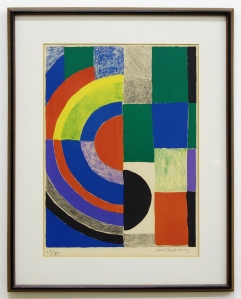Text by Brooke Follette, J Wayne Stark Gallery Attendant

Color Rhythms
c. 1970
Stone Lithograph on paper
Currently on display in the Global Vistas exhibition at the J. Wayne Stark Galleries
Although pioneers of the art world may not have to battle through foreign lands, their discoveries for the sake of art are no less monumental. Sonia Delaunay is certainly no exception to this.
Sonia Delaunay was born as Sarah Ilinitchna Stern on November 1885 to poor Ukrainian factory workers. Unable to provide her with proper care, at a young age her parents sent her to St. Petersburg where she was raised, and in 1890 adopted, by her maternal uncle; Henri Terk. Under the parenting of Henri and Anna Terk, Sarah Ilinitchna Stern changed her name to Sonia Terk and lived a privileged childhood that included many trips to museums and galleries around the world. In 1905, at the age of 18, Sonia travelled to Paris where she studied art at an accredited academy. However, Sonia’s true inspiration emanated from the work of the post-impressionist and fauvist artists exhibited in and around Paris. In 1910, Sonia met and married Robert Delaunay. Through this union, they helped to shape the Orphism movement that took hold of the early 20th century art community. The Orphism movement was a form of Cubism that focused on bold colors and abstraction. With the inspiration Orphism brought forth, Delaunay decided to take up different mediums of expression.
Sonia Delaunay is known for her bold colors and geometric designs that she incorporated in all forms in her creations; including her fashion designs, paintings, textiles, theatre, and lithography. Orphism for Delaunay represented the use of bold colors and geometric designs that would work to evoke a certain emotional resonance in the viewer. Delaunay’s “Color Rhythms” does just that. Her daring use of juxtaposing colors and mediums with conflicting geometric shapes and patterns in this piece of work to create a sense of harmony and, as the title of the piece states, rhythm.
Sonia Delaunay truly carved a path through uncharted territory in the art world with her creation of the Orphism movement. By the end of her career, Sonia Delaunay managed to have a significant presence in every form of art that she created. Because of her dedication to her arts, in 1964 Delaunay became the first living female artist to have her work in a retrospective exhibition at the Louvre in Paris, and in 1975 she was named an officer of the French Legion of Honor.
Works Cited
Nathan, Emily. “Sonia Delaunay: Reaping What She Sews.” Artnet Magazine. Accessed September 17, 2014.
De, Maryann Julio. “Sonia Delaunay.” Jewish Women: A Comprehensive Historical Encyclopedia. March 1, 2009. Jewish Women’s Archive. Accessed September 16, 2014.
Seidner, David. “Sonia Delaunay.” BOMB Magazine. January 1, 1982. Accessed September 17, 2014. http://bombmagazine.org/article/60/.